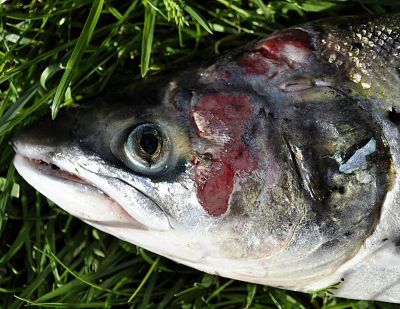Lice alert for Norwegian salmon

Your support helps us to tell the story
From reproductive rights to climate change to Big Tech, The Independent is on the ground when the story is developing. Whether it's investigating the financials of Elon Musk's pro-Trump PAC or producing our latest documentary, 'The A Word', which shines a light on the American women fighting for reproductive rights, we know how important it is to parse out the facts from the messaging.
At such a critical moment in US history, we need reporters on the ground. Your donation allows us to keep sending journalists to speak to both sides of the story.
The Independent is trusted by Americans across the entire political spectrum. And unlike many other quality news outlets, we choose not to lock Americans out of our reporting and analysis with paywalls. We believe quality journalism should be available to everyone, paid for by those who can afford it.
Your support makes all the difference.Norwegian salmon is a must-have for many during the holidays, but the pink delicacy is increasingly threatened by a small parasite spreading rapidly among farmed salmon, and, more alarmingly, their wild cousins.
This past autumn, fish farmers observed three times as many Lepeophtheirus salmonis, a tiny sea louse that feeds on the salmon's skin and mucous membranes, as last year.
Naturally present in the sea, the louse poses no risk to human consumption: it normally falls off during transport or processing, and the fish that have been esthetically damaged are usually cut up into fillets instead of being sold whole.
But the louse's rapid proliferation in the fish farms that dot the Norwegian fjords are nonetheless causing concern.
"Today, the louse is the main threat to sustainable fish farming in Norway, both because of its effects on the farmed fish and its impact on wild salmon," says Ole Fjetland of the Norwegian Food Safety Authority.
Because of the large number of fish in the farms' submerged cages, the parasite can latch onto a multitude of hosts.
"Our salmon can cope with the lice no problem," insists Ketil Rykhus of the Norwegian Seafood Federation that represents the industry.
"But what we fear is that a louse infection could lead to other illnesses," he adds.
More worrying is that, because of the strong currents or escapes from the fish farms, the parasites also infect wild salmon, in particular the smolt which are more vulnerable than the older fish, when they swim near the farms as part of their migration from the rivers to the sea during the spring.
In some fjords, between 15 and 20 percent of smolt succumb to the louse, according to estimates from the Directorate for Nature Management.
Wild Atlantic salmon stocks are already very fragile, having been almost halved since 1970, according to the International Council for the Exploration of the Sea.
The causes are not known for certain, but several factors are suspected: pollution, rising acidity levels in the water, hydroelectric dams, and breeding with escaped farmed fish which, in addition to being full of lice, weaken the wild salmon's gene pool.
Keen to protect the reputation of a sector whose exports were valued at 2.5 billion euros (3.5 billion dollars) last year, fish farmers have spent some 60 million euros this year on anti-lice measures.
And they could spend twice that next year.
While waiting to see what happens, the government has meanwhile decided to put off a decision on whether to increase salmon production by five percent in 2010.
To delouse the fish, the industry uses either chemicals or wrasse, a small fish that sucks out out the lice.
A new anti-lice campaign will be launched early next year, before the big migration of smolt, according to Jensen.
"The problem is that with fish farms, sea lice have many potential hosts all year long," says Karoline Andaur, a biologist at the Norwegian branch of the Worldwide Fund for Nature (WWF).
"The louse has become resistant to the main chemicals and in winter when the water is cold the wrasse become lethargic," she adds.
In order to protect the wild salmon, WWF has called for a slaughter of the most-infected farmed stocks.
"Out of the question, at least for the time-being," insists the Norwegian Seafood Federation.
Join our commenting forum
Join thought-provoking conversations, follow other Independent readers and see their replies
Comments